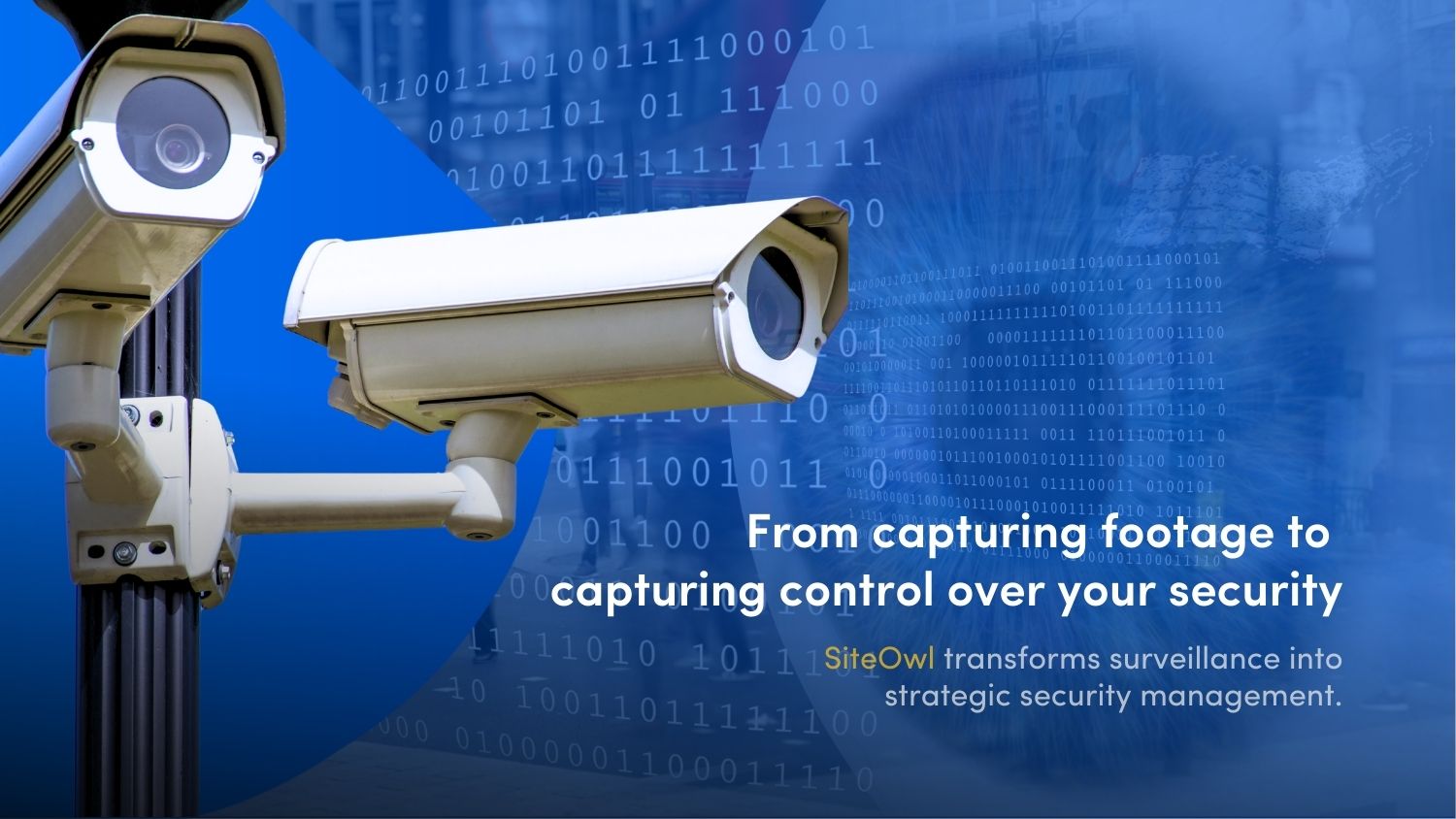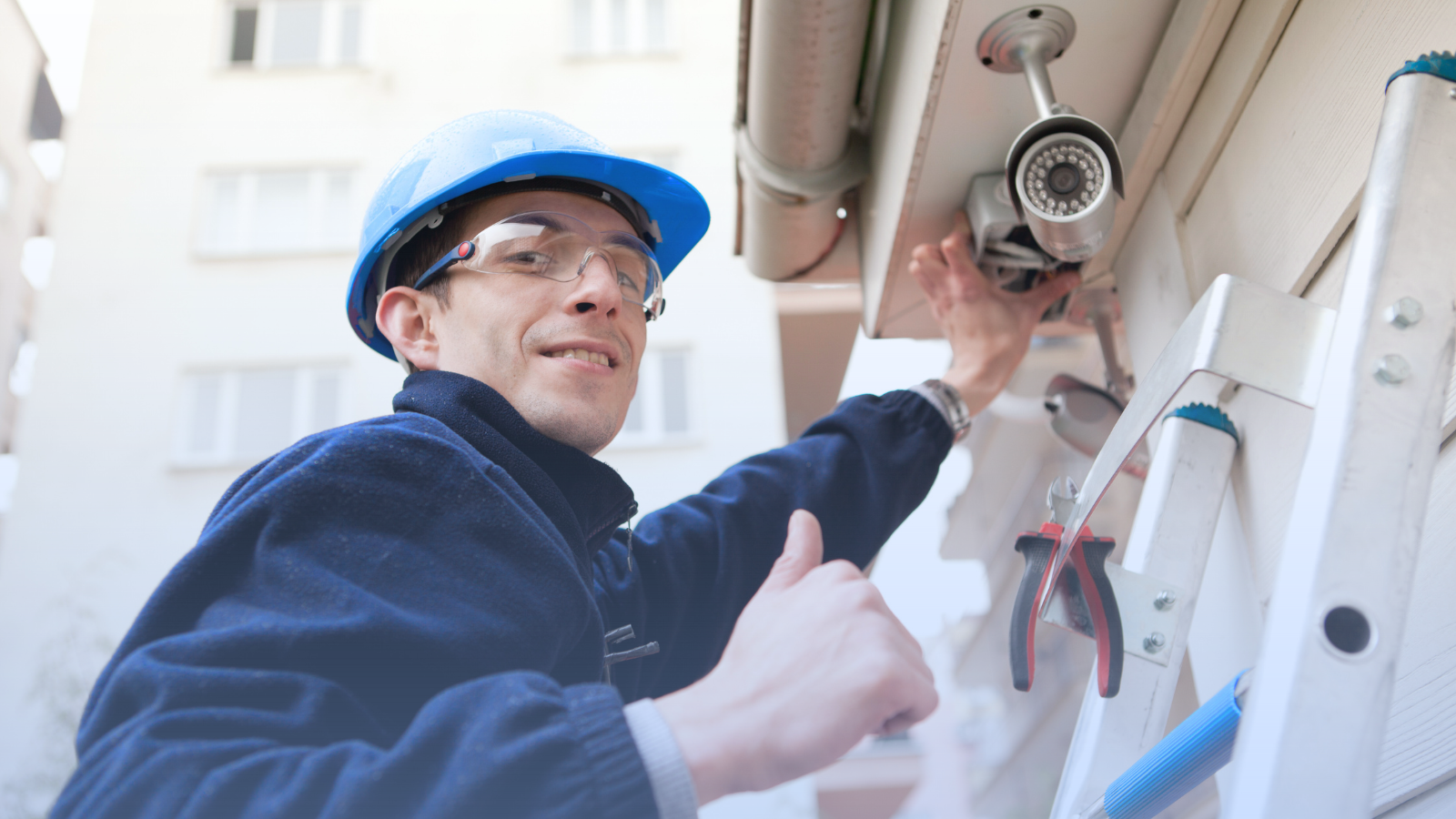Physical security is changing at the speed of light. Every day brings new tech, new threats, and a fresh wave of acronyms, but the mission stays the same: keep people, assets, and spaces safe.
Whether you’re a seasoned integrator, an operations pro, or just trying to make sense of your growing tech stack, speaking the same language helps everything run smoother.
At SiteOwl, we believe confident teams make safer spaces — and that starts with clarity. That’s why we built the S.I.T.E. Framework: a straightforward, no-fluff glossary of the physical security terms, acronyms, and concepts that actually matter.
So whether you’re rolling out a new system, reviewing a proposal, or just trying to keep up, this guide’s here to help you decode the buzzwords and make smarter decisions faster.
Quick Jump to section:
- S – Surveillance & Sensors
- I – Integration & Infrastructure
- T – Technology & Tools
- E – Entry & Egress
- Bonus: Foundations & Operations
S – Surveillance & Sensors
Surveillance and sensor tech form the eyes and ears of any modern security system. From wide-angle cameras to AI-powered sensors, this category covers the tools that help detect, record, and respond to suspicious activity in real time.
- 360° & 180° Cameras – Provide wide-angle panoramic views to cover more ground with fewer devices.
- Acoustic Sensors – Detect unusual sounds like glass breakage, gunshots, or raised voices.
- Biometric Reader – Uses fingerprint, face, or iris data to verify identity.
- CCTV (Closed-Circuit Television) – Traditional analog video systems for local monitoring.
- Cloud Video Storage – Stores surveillance footage offsite for backup and remote access.
- Dome & Bullet Cameras – Common camera types used indoors and outdoors.
- Edge-Based Processing – Cameras that analyze footage locally for faster response and reduced bandwidth.
- Fisheye Cameras – Offer ultra-wide views in a single frame.
- Glass Break Sensors – Trigger alerts when a window or glass door is broken.
- Geofencing Surveillance – Uses GPS or RFID to create virtual perimeters that trigger alerts.
- Infrared Sensors (IR) – Detect heat signatures, perfect for low-light surveillance.
- IP Cameras – Digital cameras that transmit footage over a network.
- Low-Light & Starlight Cameras – Capture high-quality images even in near-total darkness.
- Motion Detection – Identifies movement to trigger alarms or recordings.
- PIDS (Perimeter Intrusion Detection System) – Detects unauthorized access at the perimeter.
- PTZ Cameras – Pan, tilt, and zoom cameras controlled remotely.
- Radar Sensors – Detect movement across large open areas.
- Surveillance Cameras – General term for video monitoring devices.
- Thermal Imaging – Shows heat signatures, great for detecting people in darkness or smoke.
- Turret Cameras – Ball-and-socket cameras that can be easily repositioned.
- Video Surveillance Systems – Integrated platforms that capture, store, and manage video footage.
- Vibration Sensors – Trigger alarms when force or tampering is detected
I – Integration & Infrastructure
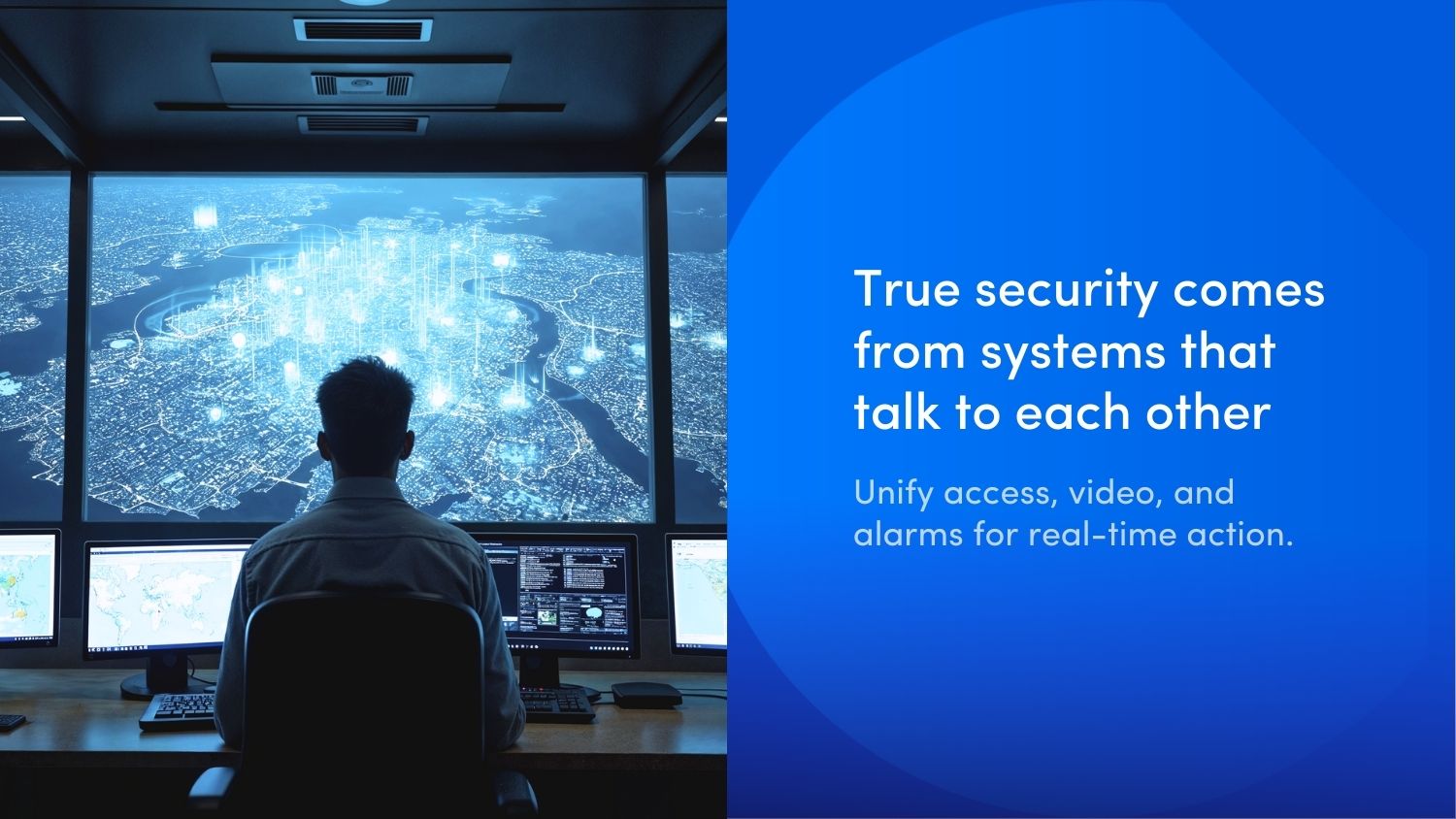
The real power of physical security comes from connection — when systems talk to each other. Integration means your access control, surveillance, and alarm systems all work together, making responses faster, smarter, and easier to manage.
-
- Access Card – A physical credential (keycard or badge) used for entry.
- Access Control System (ACS) – Manages who can enter where and when.
- Access Levels – Permission settings for different users or roles.
- Card Reader – Devices that scan access cards, fobs, or smartphones.
- Cloud-Based Access Control – Manage building access from anywhere.
- Credential Management System (CMS) – Issues and manages user credentials.
- Data Logging & Audit Trails – Tracks every access event for compliance and analysis.
- EIS (External Integrated Systems) – Connects security with lighting, HVAC, and more.
- Facial Recognition Integration – Grants access using biometric face scans.
- Fobs – Small RFID devices used for keyless entry.
- Interoperability – Ensures different technologies can work together seamlessly.
- IoT Security Integration – Connects smart devices like locks, sensors, and alarms.
- LPR (License Plate Recognition) Integration – Identifies vehicles at gates or garages.
- Magnetic Stripe – Technology used in legacy access cards.
- Mantrap Integration – Controls access using two interlocked doors for high-security areas.
- Mobile Credentialing – Uses smartphones as secure credentials.
- Physical Access Control – Any mechanism (digital or manual) that governs entry.
- PSIM (Physical Security Information Management) – Unifies all security systems into one dashboard.
- RFID (Radio-Frequency Identification) – Enables contactless access and tracking.
- SOC (Security Operations Center) – Where real-time monitoring and threat response happen.
- System Integration – Combines all your tech into one coordinated workflow.
- VMS (Video Management System) – Software for monitoring, recording, and managing video feeds.
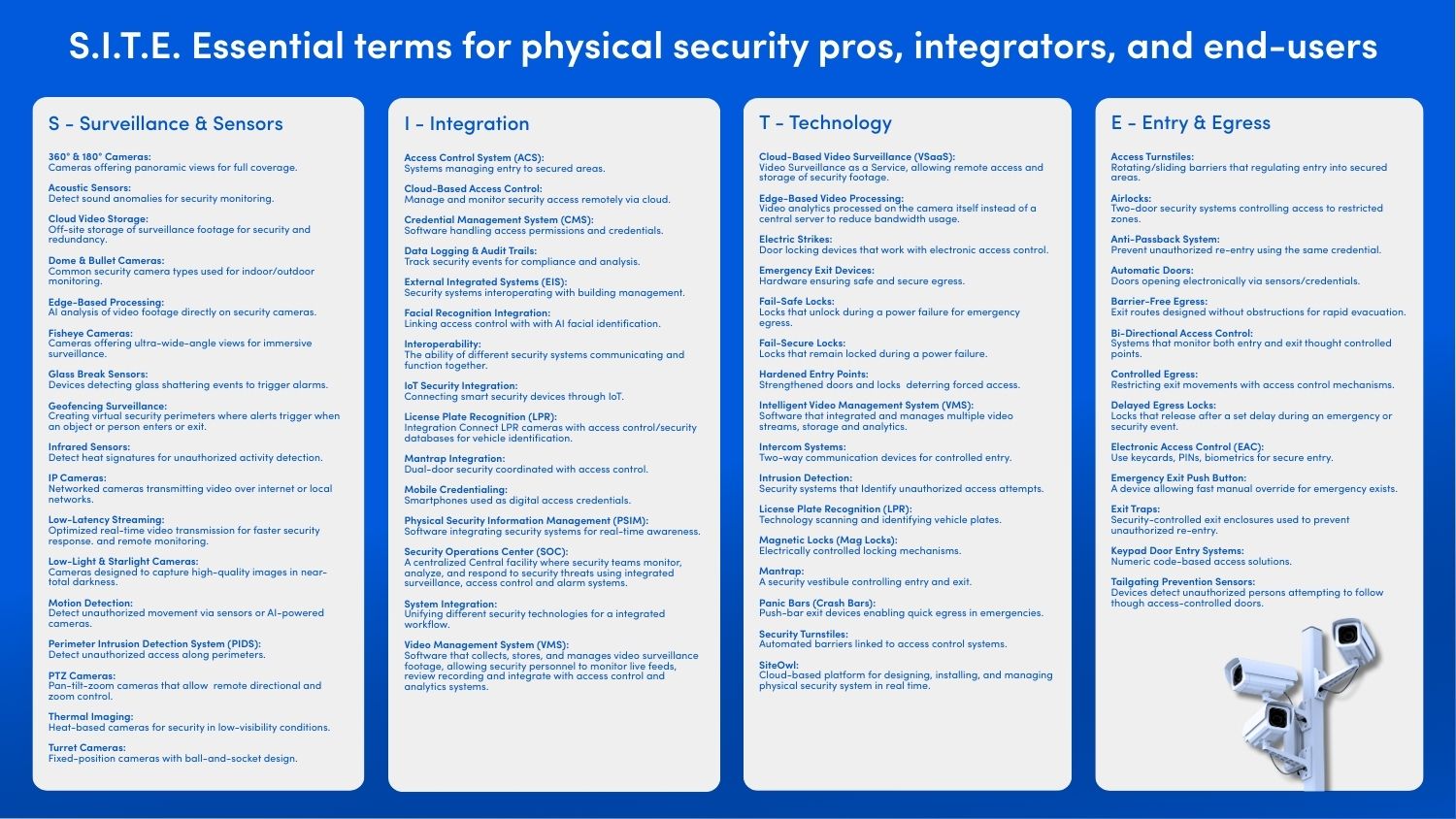
T – Technology & Tools
Tech is evolving fast — and security tech is no exception. From smart locks to cloud-first platforms, these tools form the backbone of any modern security setup. It’s not just about hardware anymore — it’s about intelligence, connectivity, and control.
-
-
- Cloud-Based Video Surveillance (VSaaS) – Hosted video platforms with remote access and storage.
- Edge-Based Video Processing – On-camera analytics that reduce network load.
- Electric Strikes – Electronically controlled door locks.
- Emergency Exit Devices – Hardware that allows for safe and fast building exits.
- Fail-Safe Locks – Unlock automatically during power failure.
- Fail-Secure Locks – Stay locked during power loss to protect restricted zones.
- Hardened Entry Points – Fortified doors, locks, and frames that resist forced entry.
- Intercom Systems – Audio/video systems for verifying visitor identity.
- Intrusion Detection – Monitors for unauthorized access or break-ins
- LPR (License Plate Recognition) – Identifies and logs vehicles entering secured areas.
- Mag Locks (Magnetic Locks) – Electromagnetic devices that secure doors.
- Panic Bars (Crash Bars) – Push-to-exit hardware for emergency egress.
- Security Turnstiles – Control pedestrian flow in and out of secured spaces.
- Smart Card – Access card with embedded microchip for secure entry.
- Smart Locks – Digital locks controlled via apps or remote software.
- Security Measures – A mix of physical and procedural controls that reduce risk.
- SiteOwl – A cloud-based platform for managing the full lifecycle of physical security systems — from design to installation to ongoing maintenance.
-
E – Entry & Egress
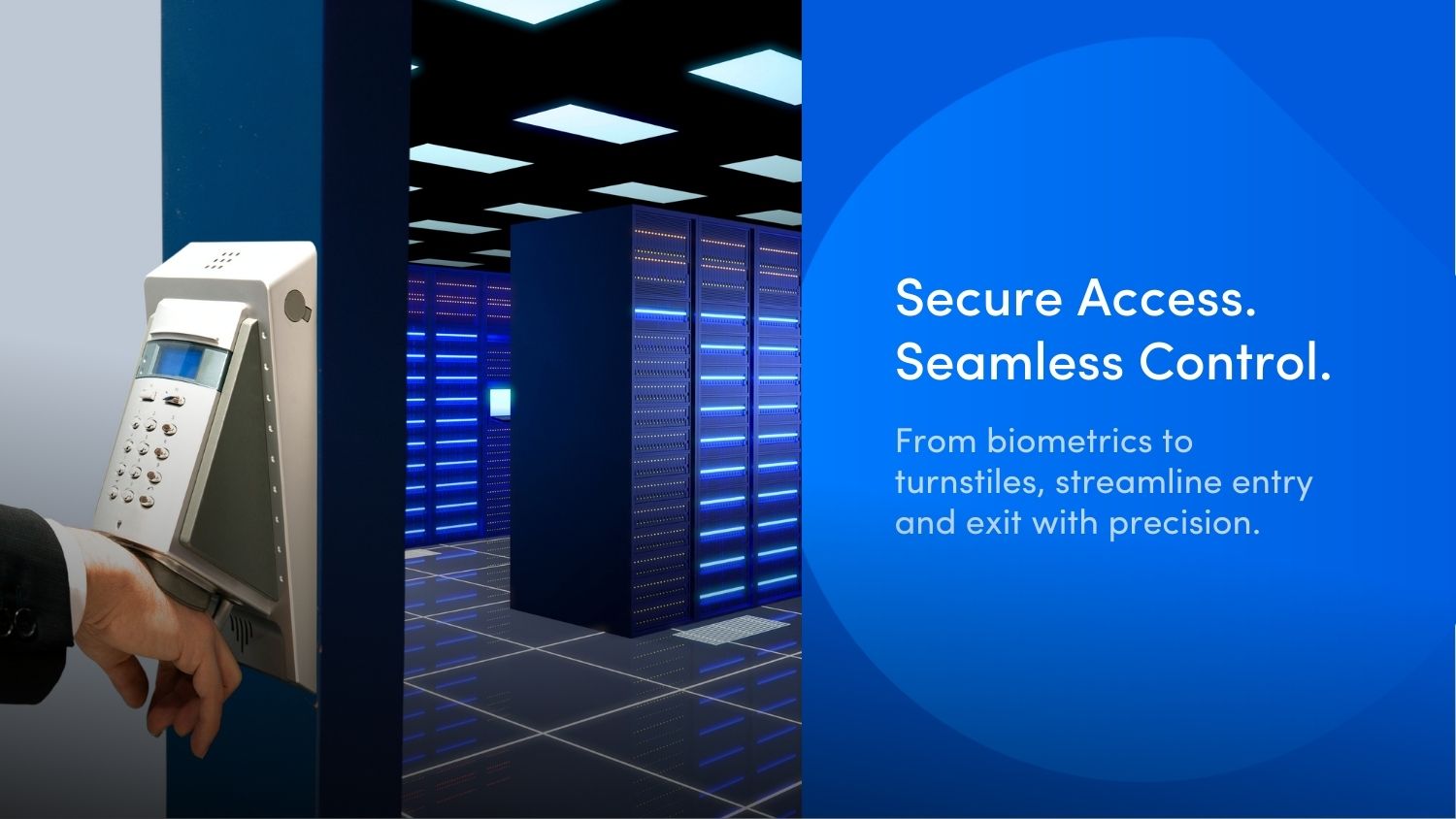
Controlling who goes where — and when — is the foundation of physical security. Entry and egress systems manage the flow of people through secure spaces while ensuring safety, compliance, and control.
-
-
- Access Turnstiles – Restrict access using rotating or sliding barriers.
- Airlocks – Two-door systems that prevent tailgating.
- Anti-Passback System – Prevents re-entry without first exiting.
- Automatic Doors – Open using sensors, fobs, or credentials.
- Barrier-Free Egress – Unobstructed exit paths for emergencies.
- Bi-Directional Access Control – Tracks both entry and exit events.
- Controlled Egress – Regulates exits from secure zones.
- Delayed Egress Locks – Hold doors for a short period before releasing.
- Electronic Access Control (EAC) – Uses PINs, cards, or biometrics to grant entry.
- Emergency Exit Push Button – Manual override for locked doors.
- Exit Traps – Secure areas that prevent unauthorized exits or re-entry.
- Keypad Entry Systems – Require codes for access.
- Mantrap Doors – Dual-door system that controls access to secure areas.
- Point of Entry – Any location where someone enters a building or space.
- Tailgating Prevention Sensors – Detect unauthorized follow-ins.
- Visitor Management System (VMS) – Tracks and logs guest access.
-
Bonus: Foundations & Operations
Some terms go beyond hardware and system design — they define how security is planned, governed, and executed. From global standards to emergency playbooks, these foundational elements support everything else in your physical security ecosystem.
-
-
- ASIS International – Global security organization offering certifications and best practices.
- Asset Management – Tracking and managing physical security equipment across locations.
- Cardholder – An individual assigned an access credential.
- Emergency Response – Procedures followed in response to security threats.
- Enterprises – Large organizations with complex, multi-site security needs.
- GSOC (Global Security Operations Center) – Central hub for global threat monitoring and coordination.
- Incident Response – The steps taken to detect, contain, and recover from an incident.
- ISO (International Organization for Standardization) – Sets international security and risk standards.
- Lifecycle Management – Planning, tracking, and maintaining security devices over time.
- NIST (National Institute of Standards and Technology) – Develops U.S. federal security frameworks.
- Physical Security Audit – Formal review of a facility’s security posture.
- Physical Security Integrator – A service provider that designs, installs, and supports integrated systems.
- Physical Security Maintenance – The ongoing upkeep of physical security devices and systems.
- Physical Security Project Management – Overseeing timelines, vendors, and budgets for installations or upgrades.
- Proactive Maintenance – Scheduled service to prevent system failures.
- Response Team – Personnel responsible for reacting to incidents or alerts.
- Risk Assessment – Evaluating vulnerabilities and threats to recommend improvements.
- Security Design – The planning and layout of systems to meet risk and compliance goals.
- Security Incident – Any event that threatens or compromises security.
- Security Management – Strategic oversight of security operations, resources, and personnel.
- Security Plan – A document outlining procedures, protocols, and goals.
- Security Policy – A formal set of rules governing acceptable use and behavior.
- Security Risks – Potential events or weaknesses that could impact safety.
- SIA (Security Industry Association) – Trade group focused on security tech standards and advocacy.
- Unauthorized Entry – Gaining access to a secured space without permission.
- Vendor Quotes – Cost estimates from third-party providers.
- Vendors – External companies that supply or support security hardware, software, or services..
-
SiteOwl speaks your language
Physical security isn’t just about hardware — it’s about connecting the right tools, teams, and terms to build safer spaces. With this glossary, you’re equipped to communicate clearly, plan smarter, and move faster.
At SiteOwl, we help security teams manage every stage of the physical security lifecycle — from design and installation to maintenance and beyond. And it all starts with speaking the same language.

David Santiago
David is a Physical Security Professional and SiteOwl contributor. From his service in the U.S. Marine Corps to leading campus-wide security initiatives, David brings deep operational insight. When not writing or consulting, he enjoys tai chi, playing basketball, and chasing the perfect beach sunset with his family.

